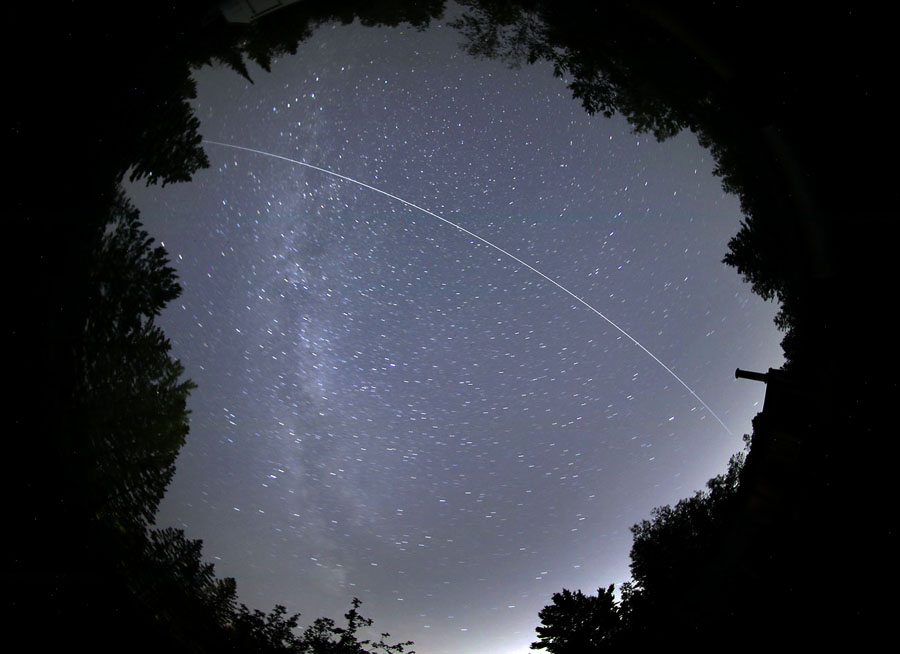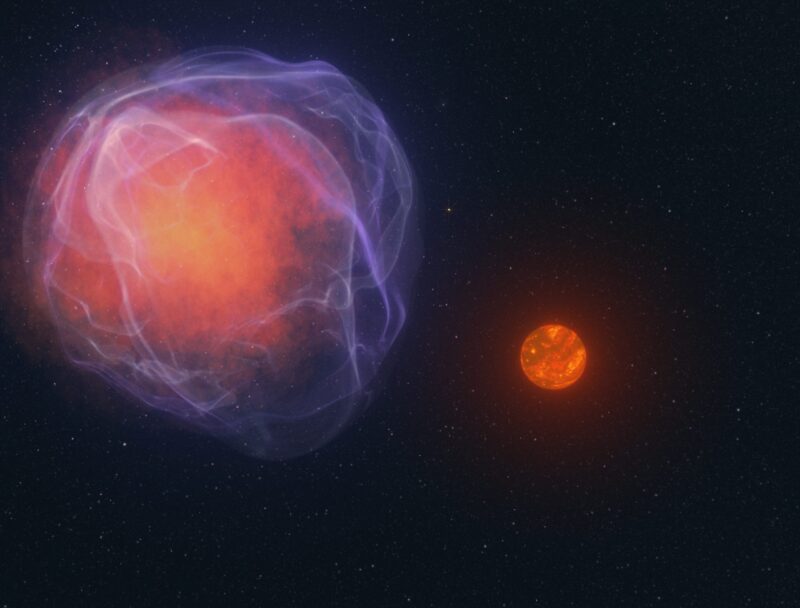Bob King
One of things I love about being an amateur astronomer is the freedom to set my own schedule and look at whatever interests me. I can spend an entire observing session with the Moon, hunt for carbon stars, or beat a path to ancient Berkeley clusters. There are so many choices, so many avenues to explore.
Lately, I’ve grown curious as to why the International Space Station (ISS) remains visible deep within Earth’s shadow long after orbital sunset. I first noticed this through binoculars a few years back. As the ISS raced into darkness, its color changed from pale yellow to orange and finally red as the Sun set on the astronauts and their ride 400 kilometers (250 miles) up. To my surprise I could still follow the stadium-sized satellite for some time after it had entered the shadow. Hmm . . . now why would that be?

Courtesy of Chris Peat / Heavens Above
My favorite satellite prediction site is Heavens Above, which lists nightly passes for a particular location along with maps showing the space station’s path. (Don’t forget to input your location in the top-right corner and select the ISS link under the Satellites heading.) When the ISS is in sunlight the path is a solid line; when in shadow, the line abruptly ends. You can see the station’s complete path — in shadow and sunlight as shown above — by bulleting All on the “ISS – Visible Passes” page for your locality.
Last January, curiosity got the better of me. How deeply into Earth’s shadow could I follow the ISS? I chose a January 19th pass when the station crossed into shadow after traversing about two-thirds of the northern sky. To track the moving light, I first nabbed it in the finderscope of my 15-inch Dob, noted the direction of travel, and then placed the crosshairs at an anticipated location. After dashing back to the eyepiece, I locked onto the speeding object and followed it with the scope like I was driving a car.
The ISS glowed with its usual luster in sunlight, then changed color when entering the shadow. Once fully engulfed, it became a ghostly white specter that dimmed to between 8th and 9th magnitude. I kept it in sight at a magnification of 64× all the way down the northeastern sky until trees blocked the view at around 15° altitude. That whetted my appetite for more. On a moonless night early last month I easily tracked it from fade-out low in the western sky till just past the zenith — then lost it in the infamous Dobson’s Hole, the Bermuda Triangle of observational agony for Dob owners.
On July 17th I was on-project again, following the ISS from rise till near setting as it dimmed from magnitude 8 to 10 along its shadowy path. I believe much of the station’s fading had to do with its increasing ground track distance rather than absolute brightness. I also observed the considerably smaller Chinese Tiangong space station later that month. After peaking at magnitude –1.4 it abruptly faded after orbital sunset to magnitude 10 and further dimmed to 12 before I lost it in the trees. Although I’ve yet to follow either all the way down to the eastern horizon I’m certain it would be possible.

NASA
So what illuminates the ISS when it’s cut off from direct sunlight? I figured that light pollution from large cities, moonlight, or even the aurora might be the cause. Seeking answers, I pitched the question to the satellite observers on the SeeSat-L mailing list. Several thought a bright Moon might be responsible, but others pointed out a problem with that hypothesis.
The full Moon shines at around magnitude –12.5, about 15 magnitudes fainter than the Sun. During its brightest passes, the ISS cranks up to about magnitude –4. Assuming the Moon is above the horizon for the astronauts, the station would likely only reach magnitude 11 in Earth’s shadow . . . or fainter. The Moon illuminates the craft from above while we observe it from below. From our perspective the Moon’s potency would be diminished. Not to mention that I’ve observed the ISS outside of full phase.

Bob King
Light pollution may play a role but it’s hard to imagine it would be significantly brighter than full moonlight at the satellite’s altitude. On the plus side, it would illuminate the bottom side of the ISS to better effect than moonlight. A fun experiment would be to compare the telescopic brightness of the station around the time of new Moon by two observers, one stationed in Wyoming, say, and another on the East Coast.
Other possibilities include natural airglow (ubiquitous around the globe though considerably fainter than human-made light pollution), aurora, and an intriguing possibility put forth by Bill Gray, creator of the Guide astrometry software. Gray suggested that lights left on inside the space station shining through one or more windows could provide the necessary illumination. His back-of-the-envelope calculation shows that a 100-watt equivalent bulb at 500 kilometers altitude would shine around magnitude 7 or 8.
“I’m wondering if somebody on the ISS could be persuaded to turn a light off and on while a groundbased observer looked with binoculars,” wrote Gray. “My guess is that they’d be happy to do a little citizen science outreach.” While he may be on to something, the several times I’ve observed the ISS in shadow it appeared larger than a point source, as if a significant fraction of the satellite were illuminated.

NASA
For my part, I’d like to offer another possible explanation — twilight. When the spacecraft flies into Earth’s shadow, it’s also illuminated for a time by the bright twilight arch in the sunset direction. Even when the Sun is hidden by the horizon, its light illuminates the lower atmosphere for many minutes. Given that it takes just 90 minutes for the ISS to orbit Earth, twilight glow — enhanced by the station’s great altitude — may contribute significantly to its visibility.

NASA
While I don’t have a definitive answer I’m interested in your thoughts. I’d also encourage you to observe the ISS for yourself when it slips into shadow. Evening passes are best because you can track the space station before it enters eclipse. The next round of favorable passes for Northern Hemisphere observers begins in early September. Have at them!




